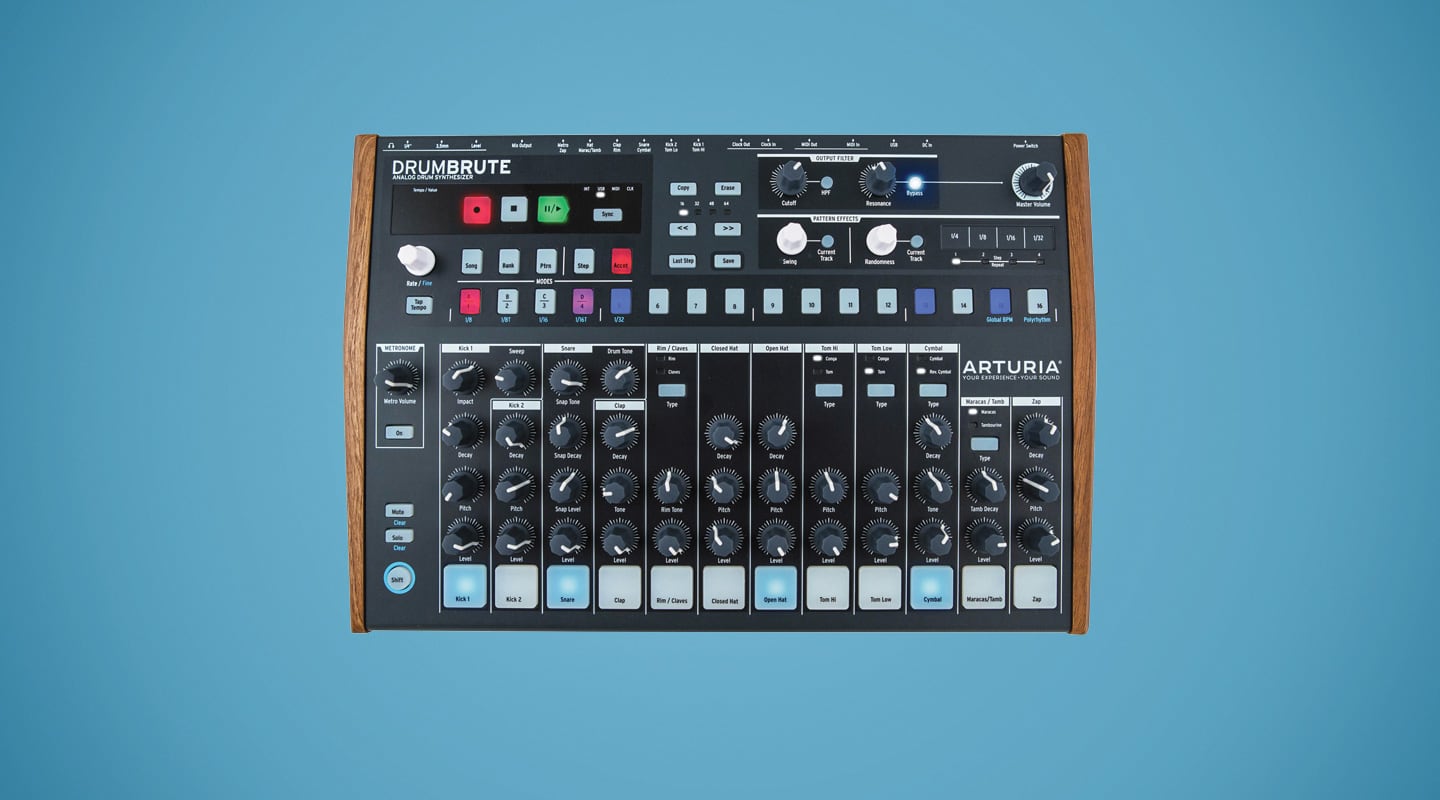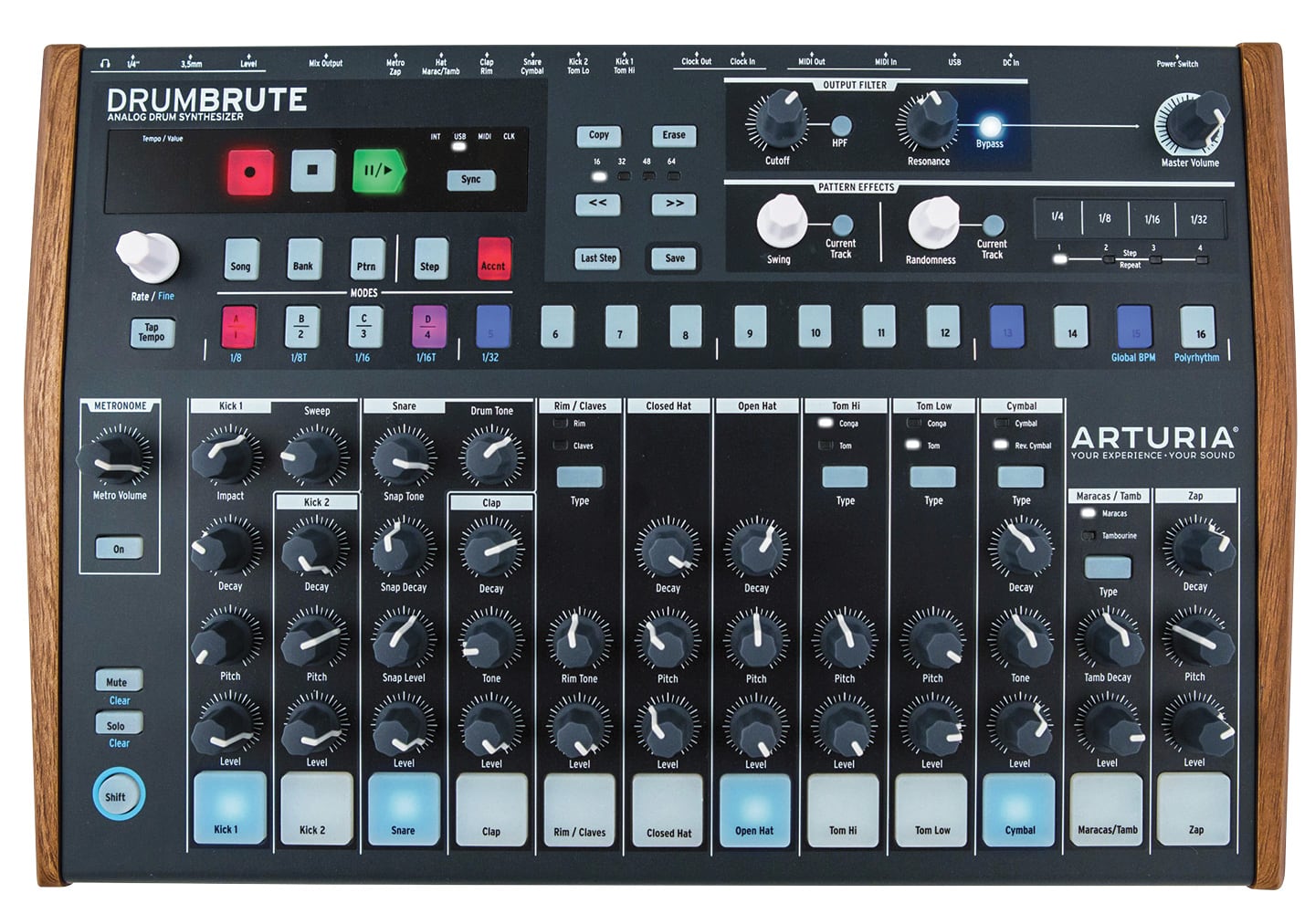
Review: Arturia Drumbrute
True analogue drum synthesis inspired by the TR808… but that’s just the beginning.
What is it about the Roland TR808 and TR909 drum machines of the early ’80s that have so entranced electronic music producers across generations?
In my favourite DAW (Reason) I have a folder of 20-odd 808 kits — they were supplied as standard. There are some subtle variations in tone and emphasis, but if I’m honest… I have 20-odd TR808 kits when one would do fine thanks.
Don’t get me wrong, I’m not an 808/909 ‘denier’. I totally understand the fascination. Back in the mid ’90s when the secondhand market was white-hot and the real thing was financially out of reach (all I could afford was a TR707 — which was great for the DIN sync but its digital samples sounded lame in comparison), I saved up for the Roland R8 MkII drum machine which had some excellent sampled 808 and 909 sounds. Then I got my hands on a copy of Propellerhead’s ReBirth, which was almost like having the real thing. Subsequently, everyone got in on the act. If you can’t lay your hands on excellent 808 samples then you probably don’t have an internet connection.
Arturia’s DrumBrute isn’t living or dying on an ability to slavishly recreate the TR808 experience. That sacred duty rightfully belongs to Roland. Saying that, it is most definitely scratching an 808 itch, and although it will contentedly sit in the studio alongside your other synths, its true value is as a performance instrument.
ANALOGUE RUNNING
Arturia has identified that an analogue drum machine (and the DrumBrute is all-analogue) is no longer a niche item for dads who can afford the $2000+ price tag. A growing cohort of electronic music producers are after a performance synth that has guts and authenticity, but they don’t necessarily have their dad’s income.
Here’s the DrumBrute’s second most compelling feature (after the all-analogue sound source): its price. For under a grand it was almost immediately worth a pre-order. Given the feature set, the more I got stuck into using the DrumBrute the more I shook my head in smiling disbelief… DrumBrute is great value.
NO CLONE
The feature set is epic. As you can see from the photo there’s a generous selection of sounds (17 in all), each with tone shaping controls. In the spirit of the 808, some channels make you choose between sources, such as maracas and tambourine. Unlike the drum machines of yore there are two kick sounds — ostensibly one for thump and the other for sub. The subby kick will please 808-o-philes — the sound will set mastering engineers the task of not skipping the needle straight out of your vinyl pressing; and I’m sure herds of pachyderm were scattering on the Serengeti during some of AT’s tests.
The sounds, in general, are all very successfully presented. Like I mentioned, if you’re searching for an 808 clone (no, there’s nothing that resembles an 808 cowbell), look elsewhere, this is a drum synth with its own story and it’s a joy to get to know its character and foibles. At times I was scratching my head as to whether a DrumBrute sound was more 909 than 808, and the truth is, I don’t care — if it sounds good then roll with it.
NEED TO KNOW
Arturia Drumbrute
Drum Synthesizer

PATTERN OF BEHAVIOUR
If you’ve ever used a step sequencer then creating a pattern is easy, and you will want to create patterns. You can even create indepth polyrhythms, with per-channel sequence lengths. Although the drum pads are fine to use, this isn’t an MPC-style workstation for those who like to drum live with their dancing digits. The performance aspects of the DrumBrute lie in the real-time manipulations, not in the silky, responsive feel of the pads.
Once you’ve created a pattern you can fine tune the sound using pattern effects — Swing and the aptly titled Randomness (either globally or per-instrument). The filter across the mix is a cool-sounding glacé cherry for shaping your buildups and the like.
Be aware: a pattern only saves the rhythm of your drum loop it doesn’t save the tone/volume settings of the instruments you’re employing within the pattern. Stepping out of a digital world into an analogue one, this is quite a shocking revelation! (The sound and volume of the instruments in your pattern are set to where the knobs are currently at!) More seriously, this does impact on how you play the DrumBrute. You’re constantly fiddling and fine tuning, muting and goosing the sounds. You may have nailed a perfect-sounding loop when you saved that pattern but chances are it’s sounding very different a day later when all the pots have been reset. If you’re an OCD producer who counts ppqn ticks in their spare time then this aspect may well drive you batty. If you love the ‘can’t wait to hear what happens next’ unpredictability of the DrumBrute in all its analogue glory, then you’ll revel in it.

CARDIE CARRYING FAN
The price really is the clincher. For sub-$700 I really have no right to expect the individual mix outputs; I probably shouldn’t expect such a broad range of sounds; while the effects and HPF/LPF are also a welcome bonus. (As an aside, the TR808 launched in 1980 with a starting price of US$1195, which itself was a much more thrifty option compared to the incumbent Linn Drum.)
This is a gutsy performer that will always deserve a place in your sonic performance arsenal. Long after the circus has left town and the latest genre craze is over, DrumBrute will reliably be knocking out solid electronic beats.
In fact, come the day you’re a cardie-wearing dad (lady readers notwithstanding), long after all your plug-ins are distant binary blips in the memory of a computer you dropped off in the e-waste bin at Officeworks, you’ll still have a powerful performance instrument as cool as the day it was released.
I think I’ve just talked myself into one.
















RESPONSES